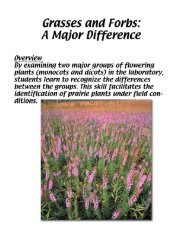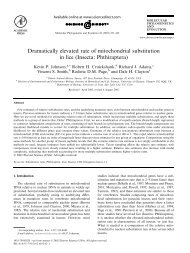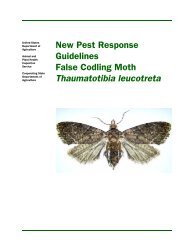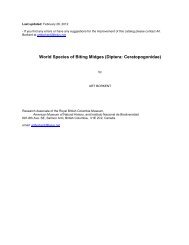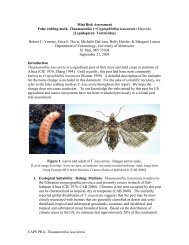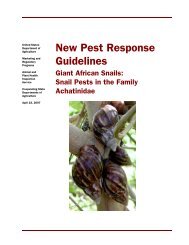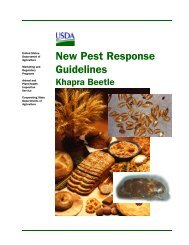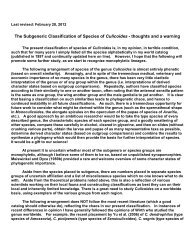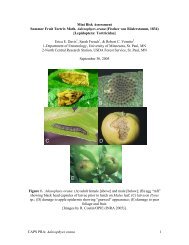Mini Risk Assessment - Light brown apple moth, Epiphyas postvittana
Mini Risk Assessment - Light brown apple moth, Epiphyas postvittana
Mini Risk Assessment - Light brown apple moth, Epiphyas postvittana
Create successful ePaper yourself
Turn your PDF publications into a flip-book with our unique Google optimized e-Paper software.
<strong>Mini</strong> <strong>Risk</strong> <strong>Assessment</strong><strong>Light</strong> <strong>brown</strong> <strong>apple</strong> <strong>moth</strong>, <strong>Epiphyas</strong> <strong>postvittana</strong> (Walker)[Lepidoptera: Tortricidae]Robert C. Venette, Erica E. Davis, Michelle DaCosta, Holly Heisler, & Margaret LarsonDepartment of Entomology, University of MinnesotaSt. Paul, MN 55108September 21, 2003Introduction<strong>Epiphyas</strong> <strong>postvittana</strong> is a highly polyphagous pest that attacks a wide number of fruitsand other plants. This species has a relatively restricted geographic distribution, beingfound only in portions of Europe and Oceania (van Den Broek 1975, Terauds 1977, IIE1991, Danthanarayana et al. 1995, Suckling et al. 1998). The pest is native to Australiabut has successfully invaded other countries (Danthanarayana 1975). The likelihood andconsequences of establishment by E. <strong>postvittana</strong> have been evaluated in pathwayinitiatedrisk assessments. <strong>Epiphyas</strong> <strong>postvittana</strong> was considered highly likely ofbecoming established in the US; the consequences of its establishment for US agriculturaland natural ecosystems were judged to be high (i.e., severe) (<strong>Light</strong>field 1995).Figure 1. Life stages of <strong>Epiphyas</strong> <strong>postvittana</strong>: (top left) eggs; (top right) larva;(bottom left) pupa, (bottom right) adults, male is on the left. (Photos fromhttp://www.hortnet.co.nz/key/keys/info/lifecycl/lba-desc.htm)CAPS PRA: <strong>Epiphyas</strong> <strong>postvittana</strong> 1
1. Ecological Suitability. Rating: High. <strong>Epiphyas</strong> <strong>postvittana</strong> is found in northernEurope, southern Australia, New Zealand, and Hawaii (IIE 1991). The climatewithin its range can be generally characterized as temperate, tropical, or dry (CAB2003). The currently reported global distribution of E. <strong>postvittana</strong> suggests thatthe pest may be most closely associated with deserts and xeric shrubland;temperate broadleaf and mixed forests; temperate grasslands, savannahs, andshrublands; and tropical and subtropical moist tropical broadleaf forests. Basedon the distribution of climate zones in the US, we estimate that approximately80% of the continental US may be climatically suitable for E. <strong>postvittana</strong> (Fig. 2).See Appendix A for a more complete description of this analysis.Figure 2. Predicted distribution of <strong>Epiphyas</strong> <strong>postvittana</strong> in the continental US.Southern Florida is enlarged for detail.2. Host Specificity/Availability. Rating: Low/High. <strong>Epiphyas</strong> <strong>postvittana</strong> has ahost range in excess of 120 plant genera in over 50 families (Geier and Briese1981) with preferences for hosts in the families Compositae, Leguminosae,Polygonaceae, and Rosaceae (Danthanarayana 1975). Host plants include:Adiantum sp., Aguilegia sp., Amaranthus sp., Arbutus sp., <strong>apple</strong> (Malusdomestica, Malus spp.), apricot (Prunus armeniaca), Artemesia sp., Astartea sp.,Aster sp., avocado (Persea americana), Baccharis sp., black alder/European alder(Alnus glutinosa), blackberry and raspberry (Rubus spp.), black poplar (Populusnigra), blueberry (Vaccinium sp.), Boronia sp., Brassica sp., Breynia sp., broadbean (Vicia faba), broadleaf dock (Rumex obtusifolius), Bursaria sp., butterflybush (Buddleia spp.), Calendula sp., Callistemon sp., camellia (Camelliajaponica), Campsis sp., capeweed (Arctotheca calendula), Cassia sp., Ceanothussp., Chinese gooseberry (Actinidia chinensis), Choisya sp., chrysanthemum(Chrysanthemum spp., Chrysanthemum x morifolium), citrus (Citrus spp.),Clematis sp., Correa sp., cotoneaster (Cotoneaster spp.), Clerodendron sp., clover(Trifolium repens, Trifolium spp.), Cupressus sp., curled dock (Rumex crispus),currant (Ribes spp.), Cydonia sp., Dahlia sp., Datura sp., Daucus sp., Dodonaeasp., Eriobotrya sp., Eriostemon sp., Escallonia sp., eucalyptus (Eucalyptus spp.),CAPS PRA: <strong>Epiphyas</strong> <strong>postvittana</strong> 2
euonymus (Euonymus spp.), fat-hen (Chenopodium album), Forsythia sp.,Fortunella sp., fox’s brush/heliotrope/valerian (Centranthus spp.), Gelsemium sp.,Genista sp., Gerbera sp., gorse (Ulex europaeus), grape (Vitis vinifera, Vitis spp.),Grevillea sp., Hardenbergia sp., hawthorn (Crataegus spp.), hebe (Hebe spp.),Helichrysum sp., hop (Humulus lupulus), horn of plenty (Feijoa sellowiana), ivy(Hedera helix, Hedera spp.), jasmine (Jasminum spp.), Juglans sp., kiwifruit(Actinidia deliciosa), Lathyrus sp., Lavendula sp., Leucodendron sp.,Leptospermum sp., Linus sp., litchi (Litchi chinensis), Lonicera sp., lucerne/alfalfa(Medicago sativa), Lupinus sp., Lycopersicum sp., Macadamia sp., malabar ebony(Diospyros spp.), Mangifera sp., Melaleuca sp., Mentha sp., Mesembryanthemumsp., Michelia sp., Monotoca sp., montbretia (Crocosmia spp.), Myoporum sp., oak(Quercus spp.), Oxalis sp., Parthenocissus sp., peach (Prunus persica), pear(Pyrus spp.), Pelargonium sp., Persoonia sp., Petroselinum sp., persimmon(Diospyros kaki), Philadelphus sp., Photinia sp., Pittosporum sp., pine (Pinusmuricata, P. radiata, Pinus spp.), plantain / ribwort (Plantago lanceolata),Platysace sp., Polygala sp., Polygonum sp., poplar / cottonwood (Populus nigra,Populus spp.), potato (Solanum tuberosum), privet (Ligustrum vulgare, Ligustrumspp.), Pteris sp., Pulcaria sp., Pyllanthus sp, Pyracantha sp., Ranunculus sp.,Raphanus sp., Reseda sp., raspberry (Rubus idaeus)/ boysenberry/olallieberry(Rubus spp.), rose (Rosa spp.), Salvia sp., Senecio sp., Scotch broom (Cytisusscoparius), Sida sp., Sisymbrium sp., Smilax sp., Sollya sp., St. John’s wort(Hypericum perforatum), strawberry (Fragaria sp.), Tithonia sp., Trema sp.,Triglochin sp., Urtica sp., Viburnum sp., Vinca sp., wattle (Acacia spp.), andwillow (Salix spp.). (Danthanarayana 1975, Terauds 1977, Geier and Briese 1980,1981, Nuttal 1983, Winter 1985, Charles et al. 1987, Tomkins et al. 1989, IIE1991, Zhang 1994, Danthanarayana et al. 1995, Lo et al. 1995, Stevens 1995,Charles et al. 1996, Dentener et al. 1996, Burnip and Suckling 1997, Glenn andHoffmann 1997, Whiting and Hoy 1997, Foster and Howard 1998, Suckling et al.1998, Brown and Il'ichev 2000, Suckling et al. 2001, Brockerhoff et al. 2002,CAB 2003).See Appendix B for maps showing where various hosts are grown in thecontinental US.3. Survey Methodology. Rating: Medium. Visual inspections have been used tomonitor population dynamics of E. <strong>postvittana</strong> eggs and larvae. In grape, 40vines were inspected per sampling date (Buchanan 1977). In <strong>apple</strong> and other treefruits, 200 shoots and 200 fruit clusters (10 of each on 20 different trees) are ofteninspected (Bradley et al. 1998, Lo et al. 2000). Egg masses are most likely to befound on leaves (USDA 1984). Larvae are most likely to be found near the calyxor in the endocarp; larvae may also create “irregular <strong>brown</strong> areas, rounds pits, orscars” on the surface of a fruit (USDA 1984). Larvae may also be found insidefurled leaves, and adults may occasionally be found on the lower leaf surface(USDA 1984).CAPS PRA: <strong>Epiphyas</strong> <strong>postvittana</strong> 3
Sex pheromone has been identified from E. <strong>postvittana</strong> and used to monitor maleflight periods. Two key components of the pheromone are (E)-11-tetradecenylacetate and (E,E)-(9,11)-tetradecadienyl acetate (Bellas et al. 1983). Thesecompounds in a ratio of 20:1 are highly attractive to males (Bellas et al. 1983).To monitor male flight activity in stands of Monterey pine (Pinus radiata) in NewZealand, 100 µg of a 95:5 ratio of (E)-11-tetradecenyl acetate: (E,E)-(9,11)-tetradecadien-1-yl acetate was placed on a rubber septum and used in delta trapswith a 20 cm x 20 cm sticky base (Brockerhoff et al. 2002). Traps were placed6.5 ft (2 m) above ground level without any understory vegetation (Brockerhoff etal. 2002). A similar procedure has been used in <strong>apple</strong>s (Thomas and Shaw 1982,Suckling et al. 1990, Suckling and Shaw 1992, Bradley et al. 1998) andcaneberries (e.g., raspberries and blackberries, Charles et al. 1996). Delta trapswere placed 5 ft (1.5 m) above the ground, and lures were changed every 6 weeks(Thomas and Shaw 1982, Suckling et al. 1990, Suckling and Shaw 1992).For a regional survey of tortricids, delta traps (20x20 cm sticky, flat base) wereplaced in each of 12 <strong>apple</strong> orchards (Cross 1996). Delta traps have also been usedwith pheromone lures to monitor male flights of E. <strong>postvittana</strong> in stone fruits(Brown and Il'ichev 2000). Frequently, traps are placed in the center of anorchard at densities in the range of 1 trap per 0.37-5 acres [=0.14-2 ha] (Bradleyet al. 1998). In vineyards, pheromone traps also have been placed at a density ofapproximately 1 trap per 5 acres [=2 ha] (Glenn and Hoffmann 1997).Foster and Muggleston (1993) provide a detailed analysis of different designs ofdelta traps. In general, they found that traps with a greater length (i.e., thedistance between the two openings of the trap) capture significantly more E.<strong>postvittana</strong> than shorter traps. This effect is not related to saturation of smallersticky surfaces with insects or other debris. The addition of barriers to slow theexit of an insect from a trap also improves catch. In a separate analysis, Foster etal. (1991) found that placing the pheromone lure on the side of the trap helped toimprove trap efficiency. The orientation of the trap relative to wind direction didnot affect the number of E. <strong>postvittana</strong> that were attracted to the pheromone orwere subsequently caught by the trap (Foster et al. 1991).Adults are also attracted to fruit fermentation products as a 10% wine solution hasbeen used as an attractant and killing agent for adults (Buchanan 1977, Glenn andHoffmann 1997). The dilute wine (670 ml) in 1 liter jars was hung fromgrapevines on the edge of a block of grapes (Buchanan 1977).Blacklight traps have been used to monitor adults of E. <strong>postvittana</strong> (Thwaite1976).4. Taxonomic Recognition. Rating: Low. <strong>Epiphyas</strong> <strong>postvittana</strong> may be confusedwith E. pulla [not known in US] and E. liadelpha [not known in US], and larvaeof several leafrollers within its range (CAB 2003). Identity of the species mustoften be confirmed by examination of adult genitalia. Molecular diagnosticsCAPS PRA: <strong>Epiphyas</strong> <strong>postvittana</strong> 4
ased on PCR amplification of ribosomal DNA have been developed and areespecially useful for the identification of immature specimens (Armstrong et al.1997).For a detailed description of the morphology and taxonomy of E. <strong>postvittana</strong>, seeAppendix C.5. Entry Potential. Rating: Low. Interceptions of E. <strong>postvittana</strong> or “<strong>Epiphyas</strong> sp.”have only been reported 55 times since 1984, primarily on rosaceous host plants(USDA 2003). Annually, about 3 (±0.7 standard error of the mean) interceptionsof E. <strong>postvittana</strong> or “<strong>Epiphyas</strong> sp.” are reported (USDA 2003). Interceptionshave been associated predominantly with international airline passengers (96%).The pest has been intercepted at three ports of entry in the United States:Honolulu (76%), Los Angeles (13%), and San Francisco (2%). These ports arethe first points of entry for airline passengers or cargo coming into the US and donot necessarily represent the intended final destination of infested material.Movement of potential infested material within the US is more fully characterizedlater in this document. The remaining interceptions (4%) were reported frompreclearance in New Zealand. <strong>Epiphyas</strong> <strong>postvittana</strong> or “<strong>Epiphyas</strong> sp.” has beenintercepted in association with 9 plant taxa. The majority (57%) listed strawberry(Fragaria sp.) as the host.International movement of E. <strong>postvittana</strong> has also been noted in Japan where thepest was intercepted 63 times at one port of entry in one year (Takahashi 2002).Nearly 40% of the interceptions were of larvae on New Zealand peppers(Takahashi 2002).6. Destination of Infested Material. Rating: Low. When an actionable pest isintercepted, officers ask for the intended final destination of the conveyance.Cargo or passengers carrying infested materials were destined for two states:Hawaii (74%) and California (26%). We note that California has a climate andhosts that would be suitable for establishment by E. <strong>postvittana</strong>.7. Potential Economic Impact. Rating: High. E. <strong>postvittana</strong> is reported as a pestof economic importance to many ornamental and fruit crops throughout its range(Zhang 1994). According to Geier (Geier and Briese 1981) “Economic damageresults from feeding by caterpillars, which may:• destroy, stunt or deform young seedlings…• spoil the appearance of ornamental plants• injure deciduous fruit-tree crops, citrus, and grapes”.E. <strong>postvittana</strong> is a difficult to control with sprays because of its leaf-rollingability, and because there is evidence of resistance due to overuse of sprays (Geierand Briese 1981). Conifers are damaged by needle-tying and chewing (Nuttal1983). Larvae have been found feeding near apices of Bishop Pine seedlingswhere they spin needles down against the stem and bore into the main stem fromCAPS PRA: <strong>Epiphyas</strong> <strong>postvittana</strong> 5
the terminal bud (Winter 1985). “After the first moult they construct typical leafrolls (nests) by webbing together leaves, a bud and one or more leaves, leaves to afruit, or by folding and webbing individual mature leaves. During the fruitingseason they also make nests among clusters of fruits, damaging the surface andsometimes tunneling into the fruits. During severe outbreaks damage to fruit maybe as high as 85%” (Danthanarayana 1975).In 1992, 70,000 larvae/ha were documented which caused a loss of 4.7t ofchardonnay fruit (Bailey et al. 1995). Damage in the 1992-93 Chardonnay seasonat Coonawarra (southern Australia) cost $2,000/ha (Bailey et al. 1996). Maturelarvae are the most difficult stage to control (Lay-Yee et al. 1997). A single larvacan destroy about 30 g of mature grapes (Bailey 1997 BAM control options).Damage to <strong>apple</strong>s is in the form of either pinpricks, which are flask-shaped holesabout 3 mm deep into the fruit, or entries, which are holes extending deeper than3 mm into the fruit that leaves some frass and webbing at the surface (van DenBroek 1975). The first generation (in spring) causes the most damage to <strong>apple</strong>swhile the second generation damages fruit harvested later in the season (Terauds1977). Some varieties of <strong>apple</strong>s such as ‘Sturmer Pippin’ (an early variety),‘Granny Smith’ and ‘Fuji’ (late varieties) can have up to 20% damage (Sucklingand Ioriatti 1996), while severe attacks can damage up to 75% of a crop (USDA1984). Peaches are damaged by feeding that occurs on the shoots and fruit (Lo etal. 1995). Following feeding damage, fruits of many host plants such as grapesare susceptible to secondary damage such as grey mold caused by Botrytis cinerea(Nair 1985).Canada has listed E. <strong>postvittana</strong> as a noxious pest, and the presence of the pestwould prevent export of any infested commodity (Danthanarayana et al. 1995). InNew Zealand, the recommended economic threshold is six or more larvae per 30m row of fruit crops, however if the crop is intended for export, control isrecommended if only one larva is found (Charles et al. 1987).8. Establishment Potential. Rating: Medium. No occurrences of E. <strong>postvittana</strong>have been reported in the wild in the US. However, this species has a broad hostrange and is likely to find suitable climatic conditions in much of the US. Thespecies may not yet be established in the US because of its apparently lowfrequency of arrival into a small number of ports.For a more detailed description of the biology of E. <strong>postvittana</strong>, see Appendix D.References:Armstrong, K. F., C. M. Cameron, E. R. Frampton, and D. M. Suckling. 1997.Aliens at the border and cadavers in the field: A molecular technique for speciesidentification, pp. 316-321, Proceedings of the 50th New Zealand Plant ProtectionConference. New Zealand Plant Protection Society, Rotorua, New Zealand. PDFBailey, P., G. Baker, and G. Caon. 1996. Field efficacy and persistence of Bacillusthuringiensis var. kurstaki against <strong>Epiphyas</strong> <strong>postvittana</strong> (Walker) (Lepidoptera:CAPS PRA: <strong>Epiphyas</strong> <strong>postvittana</strong> 6
Tortricidae) in relation to larval behaviour on grapevine leaves. Australian Journalof Entomology 35: 297-302. PDFBailey, P., A. Catsipordas, G. Baker, and B. Lynn. 1995. Traps in monitoringlight<strong>brown</strong> <strong>apple</strong> <strong>moth</strong>. The Australian Grapegrower & Winemaker: 130-132.PDFBailey, P. T. 1997. <strong>Light</strong><strong>brown</strong> <strong>apple</strong> <strong>moth</strong> control options for the 1997-8 season.Australian & New Zealand Wine Industry Journal 12: 267-270. PDFBellas, T., R. Bartell, and A. Hill. 1983. Identification of two components of the sexpheromone of the <strong>moth</strong>, <strong>Epiphyas</strong> <strong>postvittana</strong> (Lepidoptera, Tortricidae). Journalof Chemical Ecology 9: 503-512. PDFBradley, J. D. 1973. <strong>Epiphyas</strong> <strong>postvittana</strong> (Walker), pp. 126-127, British Tortricoid<strong>moth</strong>s; Cochylidae and Tortricidae; Tortricinae. The Ray Society, London. PDFBradley, J. D., W. G. Tremewan, and A. Smith. 1979. List of British species ofTortricidae: Olethreutinae, London.Bradley, S., J. Walker, C. Wearing, P. Shaw, and A. Hodson. 1998. The use ofpheromone traps for leafroller action thresholds in pipfruit., pp. 173-178,Proceedings of the 51st New Zealand Plant Protection Conference. New ZealandPlant Protection Society, Rotorua, New Zealand. PDFBrockerhoff, E., H. Jactel, A. Leckie, and D. Suckling. 2002. Species composition andabundance of leafrollers in a Canterbury pine plantation. New Zealand PlantProtection 55: 85-89. PDFBrown, D. J., and A. L. Il'ichev. 2000. The potential for the removal of organophosphateinsecticides from stone-fruit production in the Goulburn Valley,Australia. Acta Horticulturae 525: 85-91. PDFBuchanan, G. 1977. The seasonal abundance and control of light <strong>brown</strong> <strong>apple</strong> <strong>moth</strong>,<strong>Epiphyas</strong> <strong>postvittana</strong> (Walker) (Lepidoptera: Tortricidae), on grapevines inVictoria. Australian Journal of Agricultural Research 28: 125-132. PDFBuchanan, G. A., S. C. Stirrat, and D. G. Madge. 1991. Integrated control of light<strong>brown</strong> <strong>apple</strong> <strong>moth</strong>, <strong>Epiphyas</strong> <strong>postvittana</strong> (Walker), in vineyards. Wine IndustryJournal 6: 220-222. PDFBurnip, G., and D. Suckling. 1997. Evaluation of legumes for development ofleafroller-free orchard understoreys., pp. 420-424, Proceedings of the 50th NewZealand Plant Protection Conference. New Zealand Plant Protection Society,Rotorua, New Zealand. PDFCAB. 2003. Crop protection compendium: global module. Commonwealth AgriculturalBureau International, Wallingford, UK.Charles, J., V. White, and M. Cornwell. 1987. Leafroller (Lepidoptera: Tortricidae)damage to buds of raspberry canes in New Zealand. New Zealand Journal ofExperimental Agriculture 15: 491-496. PDFCharles, J., J. Walker, and V. White. 1996. Leafroller phenology and parasitism inHawke's Bay, New Zealand, canefruit gardens. New Zealand Journal of Crop andHorticultural Science 24: 123-131. PDFCross, J. V. 1996. A pheromone trap survey of tortricid <strong>moth</strong>s (Lepidoptera: Tortricidae)in <strong>apple</strong> orchards in England subject to different insecticide management. TheEntomologist 115: 168-180.CAPS PRA: <strong>Epiphyas</strong> <strong>postvittana</strong> 7
Danthanarayana, W. 1975. The bionomics, distribution and host range of the light<strong>brown</strong> <strong>apple</strong> <strong>moth</strong>, <strong>Epiphyas</strong> <strong>postvittana</strong> (Walk.) (Tortricidae). Australian Journalof Zoology 23: 419-437.Danthanarayana, W. 1983. Population ecology of the light <strong>brown</strong> <strong>apple</strong> <strong>moth</strong>, <strong>Epiphyas</strong><strong>postvittana</strong> (Lepidoptera: Tortricidae). Journal of Animal Ecology 52: 1-33. PDFDanthanarayana, W., H. Gu, and S. Ashley. 1995. Population growth potential of<strong>Epiphyas</strong> <strong>postvittana</strong>, the light<strong>brown</strong> <strong>apple</strong> <strong>moth</strong> (Lepidoptera: Tortricidae) inrelation to diet, temperature and climate. Australian Journal of Zoology 43: 381-394. PDFDentener, P., S. Alexander, P. Lester, R. Petry, J. Maindonald, and R. McDonald.1996. Hot air treatment for disinfestation of light<strong>brown</strong> <strong>apple</strong> <strong>moth</strong> and longtailedmealy bug on persimmons. Postharvest Biology and Technology 8: 143-152. PDFEvans, J. W. 1937. The light-<strong>brown</strong> <strong>apple</strong> <strong>moth</strong> (Tortrix <strong>postvittana</strong>, Walk). TheTasmanian Journal of Agriculture 8: 1-18. PDFFoster, S., and S. Muggleston. 1993. Effect of design of a sex-pheromone-baited deltatrap on behavior and catch of male <strong>Epiphyas</strong> <strong>postvittana</strong> (Walker). Journal ofChemical Ecology 19: 2617-2633. PDFFoster, S., and A. Howard. 1998. Influence of stimuli from Camelia japonica onovipositional behavior of generalist herbivore <strong>Epiphyas</strong> <strong>postvittana</strong>. Journal ofChemical Ecology 24: 1251-1275. PDFFoster, S., S. Muggleston, and R. Ball. 1991. Behavioral responses of male <strong>Epiphyas</strong><strong>postvittana</strong> (Walker) to sex pheromone-baited delta trap in a wind tunnel. Journalof Chemical Ecology 17: 1449-1468. PDFFoster, S. P., A. J. Howard, and R. H. Ayers. 1995. Age-related changes inreproductive characters of four species of tortricid <strong>moth</strong>s. New Zealand Journal ofZoology 22: 271-280. PDFGeier, P., and B. Springett. 1976. Population characteristics of Australian leafrollers(<strong>Epiphyas</strong> spp., Lepidoptera) infesting orchards. Australian Journal of Ecology 1:129-144. PDFGeier, P., and D. Briese. 1980. The light-<strong>brown</strong> <strong>apple</strong> <strong>moth</strong>, <strong>Epiphyas</strong> <strong>postvittana</strong>(Walker): 4. Studies on population dynamics and injuriousness to <strong>apple</strong>s in theAustralian Capital Territory. Australian Journal of Ecology 5: 63-93. PDFGeier, P., and D. Briese. 1981. The light-<strong>brown</strong> <strong>apple</strong> <strong>moth</strong>, <strong>Epiphyas</strong> <strong>postvittana</strong>(Walker): a native leafroller fostered by European settlement., pp. 131-155. In R.Kitching and R. Jones [eds.], The Ecology of Pests. CSIRO, Melbourne,Australia. PDFGlenn, D., and A. Hoffmann. 1997. Developing a commercially viable system forbiological control of light <strong>brown</strong> <strong>apple</strong> <strong>moth</strong> (Lepidoptera: Tortricidae) in grapesusing endemic Trichogramma (Hymenoptera: Trichogrammatidae). Journal ofEconomic Entomology 90: 370-382. PDFHampson, G. F. 1863. List of the Lepidopterous insects in the British Museum. PartXXVII. Crambites and Tortricites. British Museum of Natural History, London.IIE. 1991. <strong>Epiphyas</strong> <strong>postvittana</strong> (Walker). Distribution Maps of Pests, Series A, Map No.82 (1st revision). International Institute of Entomology/CommonwealthAgricultural Bureau., London, UK. PDFCAPS PRA: <strong>Epiphyas</strong> <strong>postvittana</strong> 8
Il'ichev, A. L., and S. P. Flett. 1999. Major pest and disease problems in stone fruitproduction in Northern Victoria, Australia. Bulletin OILB-SROP 22: 131-135.PDFKlots, A. B. 1970. Lepidoptera, pp. 13-18; 115-130. In S. L. Tuxen [ed.], Taxonomist'sglossary of genitalia in insects. Munksgaard, Copenhagen.Lay-Yee, M., D. C. Whiting, and K. J. Rose. 1997. Response of 'Royal Gala' and"Granny Smith' <strong>apple</strong>s to high-temperature controlled atmosphere treatments forcontrol of <strong>Epiphyas</strong> <strong>postvittana</strong> and Nysius huttoni. Postharvest Biology andTechnology 12: 127-136. PDF<strong>Light</strong>field, J. 1995. Movement of litchi (Litchi chinensis) fruits from Hawaii into otherregions of the United States: qualitative, pathway-initiated pest risk assessment.Animal and Plant Health Inspection Service, US Department of Agriculture,Riverdale, MD.Lo, P., and V. Murrell. 2000. Time of leafroller infestation and effect on yield in grapes.New Zealand Plant Protection 53: 173-178. PDFLo, P., V. Bohm, J. Walker, and D. Manktelow. 1995. Monitoring pests of peaches inHawke's Bay to reduce insecticide applications., pp. 107-110, Proceedings of the47th New Zealand Plant Protection Conference. New Zealand Plant ProtectionSociety. PDFLo, P., D. Suckling, S. Bradley, J. Walker, P. Shaw, and G. Burnip. 2000. Factorsaffecting feeding site preferences of light<strong>brown</strong> <strong>apple</strong> <strong>moth</strong>, <strong>Epiphyas</strong> <strong>postvittana</strong>(Lepidoptera: Tortricidae) on <strong>apple</strong> trees in New Zealand. New Zealand Journalof Crop and Horticultural Science 28: 235-243. PDFMacLellan, C. 1973. Natural enemies of the light <strong>brown</strong> <strong>apple</strong> <strong>moth</strong>, <strong>Epiphyas</strong><strong>postvittana</strong>, in the Australian Capital Territory. Canadian Entomologist 105: 681-700. PDFMadge, D. G., and S. C. Stirrat. 1991. Development of a day-degree model to predictgeneration events for light<strong>brown</strong> <strong>apple</strong> <strong>moth</strong> <strong>Epiphyas</strong> <strong>postvittana</strong> (Walker)(Lepidoptera: Tortricidae) on grapevines in Australia. Plant Protection Quarterly6: 39-42. PDFMagarey, P. A., P. R. Nicholas, and M. F. Wachtel. 1994. Control of the diseases ofgrapes in Australia and New Zealand. Wine Industry Journal 9: 197-225. PDFMcLaren, G. F., and J. A. Fraser. 1992. Leafroller and codling <strong>moth</strong> flights in CentralOtago. The Orchardist 65: 21. PDFNair, N., R. Emmett, and F. Parker. 1988. Some factors predisposing grape berries toinfection by Botrytis cinerea. New Zealand Journal of Experimental Agriculture16: 257-263. PDFNair, N. G. 1985. Fungi associated with bunch rot of grapes in the Hunter Valley.Australian Journal of Agricultural Research 36: 435-442.Nuttal, M. 1983. Planotortrix excessana (Walker), Planotortrix notophaea (Turner),<strong>Epiphyas</strong> <strong>postvittana</strong> (Walker). Forest and Timber Insects of New Zealand no. 58.PDFOlson, D. M., E. Dinerstein, E. D. Wikramanayake, N. D. Burgess, G. V. N. Powell,E. C. Underwood, J. A. D'Amico, I. Itoua, H. E. Strand, J. C. Morrison, C. J.Loucks, T. F. Allnutt, T. H. Ricketts, Y. Kura, J. F. Lamoreux, W. W.CAPS PRA: <strong>Epiphyas</strong> <strong>postvittana</strong> 9
Wettengel, P. Hedao, and K. R. Kassem. 2001. Terrestrial ecoregions of theworld: a new map of life on earth. BioScience 51: 933-938. PDFScott, R. R. 1984. New Zealand pest and beneficial insects. Lincoln University Collegeof Agriculture, Canterbury, New Zealand.Stevens, P. 1995. Host preferences of Trichogrammatoidea bactrae fumata (Hym.:Trichogrammatidae) an egg parasitoid of leafrollers (Lep.: Tortricidae).Entomophaga 40: 379-385. PDFSuckling, D., and P. Shaw. 1992. Conditions that favor mating disruption of <strong>Epiphyas</strong><strong>postvittana</strong> (Lepidoptera: Tortricidae). Environmental Entomology 21: 949-956.Suckling, D., and C. Ioriatti. 1996. Behavioral responses of leafroller larvae to <strong>apple</strong>leaves and fruit. Entomologia Experimentalis et Applicata 81: 97-103. PDFSuckling, D., P. Shaw, J. Khoo, and V. Cruickshank. 1990. Resistance management oflight<strong>brown</strong> <strong>apple</strong> <strong>moth</strong>, <strong>Epiphyas</strong> <strong>postvittana</strong> (Lepidoptera: Tortricidae) bymating disruption. New Zealand Journal of Crop and Horticultural Science 18:89-98. PDFSuckling, D., J. Brunner, G. Burnip, and J. Walker. 1994. Dispersal of <strong>Epiphyas</strong><strong>postvittana</strong> (Walker) and Planotortrix octo Dugdale (Lepidoptera: Tortricidae) ata Canterbury, New Zealand orchard. New Zealand Journal of Crop andHorticultural Science 22: 225-234. PDFSuckling, D., G. Burnip, A. Gibb, J. Daly, and K. Armstrong. 2001. Plant and hosteffects on the leafroller parasitoid Dolichogenidia tasmanica. EntomologiaExperimentalis et Applicata 100: 253-260. PDFSuckling, D., G. Burnip, J. Walker, P. Shaw, G. McLaren, C. Howard, P. Lo, V.White, and J. Fraser. 1998. Abundance of leafrollers and their parasitoids onselected host plants in New Zealand. New Zealand Journal of Crop andHorticultural Science 26: 193-203. PDFTakahashi, G. 2002. Notes on the light <strong>brown</strong> <strong>apple</strong> <strong>moth</strong>, <strong>Epiphyas</strong> <strong>postvittana</strong>(Walker) intercepted at import plant quarantine of Narita Airport in Japan.Research Bulletin of the Plant Protection Service, Japan 38: 99-103. PDFTerauds, A. 1977. Two methods of assessing damage to <strong>apple</strong>s caused by light <strong>brown</strong><strong>apple</strong> <strong>moth</strong>, <strong>Epiphyas</strong> <strong>postvittana</strong> (Walker). Journal of Australian EntomologicalSociety 16: 367-369. PDFThomas, W. 1989. <strong>Epiphyas</strong> <strong>postvittana</strong> (Walker), light<strong>brown</strong> <strong>apple</strong> <strong>moth</strong> (Lepidoptera:Tortricidae), pp. 187-195. In P. Cameron, R. Hill, J. Bain and W. Thomas [eds.],A review of biological control of invertebrate pests and weeds in New Zealand1874 - 1987. DSIR Entomology Division, Wallingford, UK. PDFThomas, W. P. 1975. Additional notes on leaf rollers. Orchardist of New Zealand 48:354-355. PDFThomas, W. P., and P. W. Shaw. 1982. An attempt to control the light <strong>brown</strong> <strong>apple</strong><strong>moth</strong>, <strong>Epiphyas</strong> <strong>postvittana</strong> (Walk.) (Lepidoptera: Tortricidae) by male removal,pp. 71-78. In R. A. Galbreath [ed.], Insect pheromones and their application.Entomology Division, DSIR, Auckland, New Zealand. PDFThwaite, W. 1976. Effect of reduced dosage of azinphos-methyl on control of codling<strong>moth</strong>, Cydia pomonella (L.) and light-<strong>brown</strong> <strong>apple</strong> <strong>moth</strong>, <strong>Epiphyas</strong> <strong>postvittana</strong>(Walk.), in an <strong>apple</strong> orchard. Zeitschrift für Angewandte Entomologie 80: 94-102.PDFCAPS PRA: <strong>Epiphyas</strong> <strong>postvittana</strong> 10
Tomkins, A., D. Penman, and R. Chapman. 1989. Effect of temperature and host planton development of three species of leafrollers (Lepidoptera: Tortricidae). NewZealand Entomologist 12: 48-54. PDFUSDA. 1984. Pests not known to occur in the United States or of limited distribution No.50: <strong>Light</strong>-<strong>brown</strong> <strong>apple</strong> <strong>moth</strong>, pp. 1-12. APHIS-PPQ, Hyattsville, MD. PDFUSDA. 2003. Port Information Network (PIN-309): quarantine status database. USDepartment of Agriculture, Animal and Plant Health Inspection Service, PlantProtection and Quarantine, Riverdale, MD. restricted access database.van Den Broek, W. 1975. The effect of temperature on damage to stored <strong>apple</strong>s by thelight-<strong>brown</strong> <strong>apple</strong> <strong>moth</strong>, <strong>Epiphyas</strong> <strong>postvittana</strong> (Walker), and the effect of coldstorage on its viability. Journal of the Australian Entomological Society 14: 1-5.PDFWhiting, D., and L. Hoy. 1997. Mortality response of light<strong>brown</strong> <strong>apple</strong> <strong>moth</strong> to acontrolled atmosphere cold storage treatment for apricots., pp. 431-435,Proceedings of the 50th New Zealand Plant Protection Conference. New ZealandPlant Protection Society, Rotorua, New Zealand. PDFWinter, T. 1985. A new larval food plant for <strong>Epiphyas</strong> <strong>postvittana</strong> (Walker)(Lepidoptera: Tortricidae) in Cornwall. Entomologist's Gazette 36: 1. PDFZhang, B. C. 1994. Index of economically important Lepidoptera. CAB International,Wallingford, UK.Zimmerman, E. C. 1978. Insects of Hawaii: Microlepidoptera. University Press ofHawaii, Honolulu.Appendix A. Comparison of climate zones. To determine the potential distribution ofa quarantine pest in the US, we first collected information about the worldwidegeographic distribution of the species (CAB 2003). We then identified which biomes(i.e., habitat types), as defined by the World Wildlife Fund (Olson et al. 2001), occurredwithin each country or municipality reported for the distribution of the species. Biomeswere identified using a geographic information system (e.g., ArcView 3.2). An Excelspreadsheet summarizing the occurrence of biomes in each nation or municipality wasprepared. The list was sorted based on the total number of biomes that occurred in eachcountry/municipality. The list was then analyzed to determine the minimum number ofbiomes that could account for the reported worldwide distribution of the species. Biomesthat occurred in countries/municipalities with only one biome were first selected. Wethen examined each country/municipality with multiple biomes to determine if at leastone of its biomes had been selected. If not, an additional biome was selected thatoccurred in the greatest number of countries or municipalities that had not yet beenaccounted for. In the event of a tie, the biome that was reported more frequently from theentire species’ distribution was selected. The process of selecting additional biomescontinued until at least one biome was selected for each country. The set of selectedbiomes was compared to the occurrence of those biomes in the US.CAPS PRA: <strong>Epiphyas</strong> <strong>postvittana</strong> 11
Appendix B. Commercial production of hosts of<strong>Epiphyas</strong> <strong>postvittana</strong> in the continental US.Map 1. Alfalfa (Medicago sativa)Map 2. Apple (Malus domestica)Map 3. Apricot (Prunus armeniaca)Map 4. Avocado (Persea americana)Map 5. Blackberry (Rubus spp.)CAPS PRA: <strong>Epiphyas</strong> <strong>postvittana</strong> 12
Map 6. Blueberry (Vaccinium spp.)Map 7. Boysenberry (Rubus spp.)Map 8. Broccoli (Brassica oleracea var. botrytis)Map 9. Brussels sprouts (Brassica oleracea var.gemmifera)Map 10. Carrot (Dacus carota ssp. sativus)Map 11. Cauliflower (Brassica oleracea var. botrytis)CAPS PRA: <strong>Epiphyas</strong> <strong>postvittana</strong> 13
Map 12. Cabbage; Chinese (Brassica chinensis)Map 13. Cabbage; head (Brassica oleracea)Map 14. Chrysanthemum; cut (Chrysanthemum spp.)Map 15. Chrysanthemum; potted (Chrysanthemumspp.)Map 16. Clover (Trifolium spp.)Map 17. Cottonwood; black (Populus trichocarpa)CAPS PRA: <strong>Epiphyas</strong> <strong>postvittana</strong> 14
Map 18. Cottonwood-fremont (Populus fremontii)Map 19. Cottonwood-narrowleaf (Populusangustifolia)Map 20. Cottonwood; swamp (Populus heterophylla)Map 21. Currant (Ribes spp.)Map 22. Geranium (Pelargonium spp.)Map 23. Grape (Vitis spp.)CAPS PRA: <strong>Epiphyas</strong> <strong>postvittana</strong> 15
Map 24. Grapefruit (Citrus paradiss Mac. Fad.)Map 25. Kale (Brassica alboglabra L.H. Bailey)Map 26.Kiwifruit (Actinidia chinensis)Map 27. Kumquat (Fortunella spp.)Map 28. Lemon (Citrus limon)Map 29. Lime (Citrus aurantfolia)CAPS PRA: <strong>Epiphyas</strong> <strong>postvittana</strong> 16
Map 30. Macadamia Nut (Macadamia ternifolia)Map 31. Mango (Mangifera indica)Map 32. Marigold (Calendula spp.)Map 33.Mint; for oil (Mentha spp.)Map 34. Oak (Quercus spp.)Map 35.Orange (Citrus spp.)CAPS PRA: <strong>Epiphyas</strong> <strong>postvittana</strong> 17
Map 36. Parsley (Petroselinum spp.)Map 37. Peach (Prunus persica)Map 38. Pea; dry edible (Lathyrus)Map 39. Pear (Pyrus communis)Map 40. Persimmons (Diospyros spp.)Map 41. Pine (Pinus spp.)CAPS PRA: <strong>Epiphyas</strong> <strong>postvittana</strong> 18
Map 42. Radish (Raphanus spp.)Map 43. Raspberry (Rubus spp.)Map 44. Rose; cut (Rosa spp.)Map 45. Rose; potted (Rosa spp.)Map 46. Tangelo (Citrus tangelo)Map 47. Tangerine; honey (Citrus reticulata)CAPS PRA: <strong>Epiphyas</strong> <strong>postvittana</strong> 19
Map 48. Tangerine; other (Citrus reticulata)Map 49. Walnut; English (Juglans regia)Map 50. Willow; arroyo (Salix lasiolepis)Map 51. Willow; Bebb (Salix bebbiana)Map 52. Willow; coyote (Salix exigua)Map 53. Willow; Geyer (Salix geyeriana)CAPS PRA: <strong>Epiphyas</strong> <strong>postvittana</strong> 20
Map 54. Willow; Hinds (Salix hindsiana)Map 55. Willow; Hooker (Salix hookeriana)Map 56. Willow; Mackenzie (Salix mackenzieana)Map 57. Willow; northwest (Salix sessilifolia)Map 58. Willow; peachleaf (Salix amygdaloides)Map 59. Willow; Scouler (Salix scouleriana)CAPS PRA: <strong>Epiphyas</strong> <strong>postvittana</strong> 21
Map 60. Willow; shining (Salix lucida)Map 61. Willow; Sitka (Salix sitchensis)CAPS PRA: <strong>Epiphyas</strong> <strong>postvittana</strong> 22
Appendix C. Taxonomy of <strong>Epiphyas</strong> <strong>postvittana</strong> (Walker) and related Tortricidae(prepared by M. DaCosta)Figure C1. Sketch of <strong>Epiphyas</strong> <strong>postvittana</strong> adult[image from http://www.hortnet.co.nz/publications/hortfacts/images/ hf401003.gif]Synonyms (provided by John Brown, National Museum of Natural History, personalcommunication)At the generic level:<strong>Epiphyas</strong> Turner 1927, Pap. Roy. Soc. Tasmania 1926: 125. Type species: <strong>Epiphyas</strong>eucyrta Turner, 1926.• Austrotortrix Bradley, 1956, Bull. Entomol. Res. 47: 101. Type species: Teras<strong>postvittana</strong> Walker, 1863.• Austerotortrix Razowski, 1977, Journal: 00. [misspelling of Austrotrix]At the species level:<strong>postvittana</strong> Walker, 1863 (Teras), List Spec. Lepid. Ins. Colln. Brit. Mus. 28: 297. TL:Australia (Sydney). HT (♀): BMNH.• scitulana Walker, 1863 (Teras), List. Spec. Lepid. Ins. Colln.. Brit. Mus. 28:298. TL: Australia (Sydney). HT (♂): BMNH.• basialbana Walker, 1863 (Teras), List Spec. Lepid. Ins. Colln. Brit. Mus. 28:299. TL: Australia. HT (♂): BMNH.• secretana Walker, 1863 (Teras), List Spec. Lepid. Ins. Colln. Brit. Mus. 28:300. TL: Australia. HT (♀): BMNH.• consociana Walker, 1863 (Pandemis), List Spec. Lepid. Ins. Colln. Brit. Mus.28: 311. TL: Australia (Sydney). HT (♀): BMNH.• reversana Walker, 1863 (Dichelia), List Spec. Lepid. Ins. Colln. Brit. Mus.28: 321. TL: Australia (Sydney). HT (♂): BMNH.• foedana Walker, 1863 (Dichelia), List Spec. Lepid. Ins. Colln. Brit. Mus. 28:321. TL: Australia. HT (♀): BMNH.• retractana Walker, 1863 (Dichelia), List Spec. Lepid. Ins. Colln. Brit. Mus.28: 322. TL: Australia. HT (♀): BMNH.• vicariana Walker, 1869 (Dichelia), Char. Undescr. Heter.: 82. TL: Australia.HT: NMVM.• stipularis Meyrick, 1910 (Totrix), Proc. Linnean Soc. N.S. Wales 35: 226. TL:Australia (Victoria, Murtoa). HT (♂): Lyell Collection.CAPS PRA: <strong>Epiphyas</strong> <strong>postvittana</strong> 23
• pyrrhula Meyrick, 1910 (Tortrix), Proc. Linnean Soc. N.S. Wales 35: 226.TL: Australia (South Australia, Port Lincoln). LT: BMNH.• oenopa Meyrick, 1910 (Tortrix), Proc. Linnean Soc. N.S. Wales 35: 230. TL:Australia (Victoria). HT (♂): Lyell Collection.• dissipata Meyrick, 1922 (Tortrix), Exotic Microlepid. 2: 496. TL: Australia(Yallingup). HT: BMNH.• phaeosticha Turner, 1939 (Tortrix), Pap. Proc.. Roy. Soc. Tasmania 1938: 76.TL: Tasmania. HT: Unknown.• vicaureana Bradley, 1957 (Dichelia), Bull. Entomol. Res. 47: 103.[misspelling of vicariana].Male 16-21 mm, female 17-25 mm. Sexual dimorphism pronounced; male usuallysmaller, antenna weakly dentate-ciliate, length of cilia approximately equal to width offlagellum, basal half of forewing usually sharply demarcated, well-developed costal foldfrom base to about two-fifths; antenna of female minutely ciliate, forewing longer, apexproduced (Fig C2).Diagnosis of <strong>Epiphyas</strong> <strong>postvittana</strong> [Description from Bradley et al (1973)]Male E. <strong>postvittana</strong> (Walker) is usually distinguished by the abrupt division of theforewing medially into a pale basal area and darker apical area, and the female by itslarge size and relatively elongate forewing, often with greatly reduced markings (Fig.C2).ABCDFigure C2. Dorsal views of <strong>Epiphyas</strong> <strong>postvittana</strong> (Walker), A-male, B-female, C-male,D-female [Reproduced from Bradley et al. (1979)]CAPS PRA: <strong>Epiphyas</strong> <strong>postvittana</strong> 24
DescriptionHead: No verbal description available. But, see Fig. C3.ANTENNAOCELLUSLABIAL PALPPROBSCISFigure C3. Lateral view of head of <strong>Epiphyas</strong> <strong>postvittana</strong> (Walker)-male[Reproduced from from Zimmerman (1978)]Female body: [Description from Hampson (1863)] Palpi extends forward horizontally,as long as the breadth of the head; second joint fringed above; third conical, very minute,not more than one-sixth of the length of the second. Abdomen yellowish ash-colored.Male wings: As in Figure C2. [Description from Bradley et al (1973)] Basal half offorewing light buff or pale yellow, contrasting strongly with the dark <strong>brown</strong> and rustyred-<strong>brown</strong> coloration of the distal half, the demarcation often emphasized by the deepercoloration of the oblique, narrow median fascia, the inner edge of which is sharplydefined and usually straight, but sometimes is slightly wavy at the middle; pre-apical spotobscure, its inner margin usually defined by rusty red-<strong>brown</strong> ground coloration separatingit from the median fascia. Hindwing gray.Female wings: As in Figure C2. [Description from Bradley et al (1973)] Generalcoloration of the forewing more uniform, with less contrast between the basal and distalhalves; median fascia usually reduced.Wing variation: Figure C4 describes variation that may be encountered in wing patternsand provides explanation of morphological terminology. [Description from Bradley et al(1973)] <strong>Epiphyas</strong> <strong>postvittana</strong> (Walker) is extremely variable with numerous recurringforms. In strongly marked forms of the male the distal half of the forewing may varyfrom reddish <strong>brown</strong> to blackish, often with purplish mottling; the contrasting pale basalhalf may be sparsely speckled with black. <strong>Light</strong>ly marked forms resembling the female inappearance occur; an extreme form in which the usually dark outer half of the forewing islight and the pre-apical spot discernible is uncommon (Fig. C2-C). Only minor variationis found in the female; often the forewing is irrorate with black in both the basal anddistal halves of the wing (Fig. C2-D).CAPS PRA: <strong>Epiphyas</strong> <strong>postvittana</strong> 25
Figure. C4. Variation in wing patterns of Tortricoid <strong>moth</strong>s[Reproduced from Bradley et al. (1979)]CAPS PRA: <strong>Epiphyas</strong> <strong>postvittana</strong> 26
Venation: No verbal description available, but see Figure C5.CFRENULUMFigure C5. Wing venation of <strong>Epiphyas</strong> <strong>postvittana</strong> (Walker)-male. Veins: A-anal; C-Costa, Cu-Cubitus (CuA1-1st anterior cubitus; CuA2-2 nd anterior cubitus; CuP-posteriorcubitus); M-Media, R-Radius, Sc-Subcosta.[Reproduced from Zimmerman (1978)]Male genitalia: [Description from Zimmerman (1978)] The internal sac of the aedeagusbears two to four long, narrow, flattened cornuti. These are deciduous and may bemissing from mated specimens. When the cornuti are shed the points of articulation canstill be seen (Fig C6)Terminology follows Klots (1970).AEDEAGUSVALVEABFigure C6. Ventral view of male genitalia of <strong>Epiphyas</strong> <strong>postvittana</strong> (Walker): A-genitalcapsule; B-cornuti [Reproduced from Zimmerman (1978)]CAPS PRA: <strong>Epiphyas</strong> <strong>postvittana</strong> 27
Female genitalia: No verbal description, but see Fig. C7.PAPILLA ANALISPOSTERIOR APOPHYSISANTERIOR APOPHYSISSIGNUMDUCTUS BURSASIGNUMCORPUSBURSACORPUS BURSAABPAPILLA ANALISFigure C7. Female genitalia of <strong>Epiphyas</strong> <strong>postvittana</strong> (Walker). A-entire genitalia, B-detail corpus bursa, C-detail papillae anales and associated structures[Reproduced from Zimmerman (1978)].CCAPS PRA: <strong>Epiphyas</strong> <strong>postvittana</strong> 28
Larvae: No verbal description, but see Fig.C8.POSTERIORANTERIORFigure C8. Lateral view of <strong>Epiphyas</strong> <strong>postvittana</strong> (Walker) larva[Reproduced from Scott (1984)]Pupae: No verbal description, but see Fig C9. Length 10.5mmCABFigure C9. Pupa of <strong>Epiphyas</strong> <strong>postvittana</strong> (Walker): A-ventral view , B-dorsal view ,C-detail lateral view left side cauda of pupa. In A: cx2-mesocoxa; f1-profemora; lblabrum;lp-labial palpus, l1, l2, l3-legs; mx-galea of maxilla (probscis); W2-hindwing[Reproduced from Zimmerman (1978)].CAPS PRA: <strong>Epiphyas</strong> <strong>postvittana</strong> 29
Similar species:A key to the larvae and pupae of <strong>Epiphyas</strong> <strong>postvittana</strong> (Walker) and Amorbia emigratellaBusck is provided in Zimmerman (Zimmerman 1978).Figure C10. Amorbia emigratella Busck[Reproduced from Zimmerman (1978)][Description from Zimmerman (1978)] <strong>Epiphyas</strong> <strong>postvittana</strong> can be distinguished fromAmorbia emigratella by:1) The presence of ocelli which are absent in A. emigratella.2) The undersides of the hindwings of E. <strong>postvittana</strong> are conspicuously spotted whereasthose of A. emigratella are not.3) A. emigratella has a conspicuous median pit in the second abdominal tergite near thebase, while E. <strong>postvittana</strong> does not.4) The larvae of both are green but there is a black line on each lateral margin ofA. emigratella larvae which is absent in the larvae of E. <strong>postvittana</strong>.Head: See Fig C11.ANTENNALABIAL PALPFigure C11. Lateral view of head of Amorbia emitratella Busck-male[Reproduced from Zimmerman (1978)]CAPS PRA: <strong>Epiphyas</strong> <strong>postvittana</strong> 30
Venation: As in Fig. C12.FRENULUMFigure C12. Venation of Amorbia emigratella Busck –male.[Reproduced from Zimmerman (1978)].Male genitalia: As in Fig. C13.UNCUSVALVEFigure C13. Ventral view male genitalia Amorbia emigratella Busck[Reproduced from Zimmerman (1978)].CAPS PRA: <strong>Epiphyas</strong> <strong>postvittana</strong> 31
Female genitalia: As in Fig. C14.PAPPILA ANALISDUCTUS BURSACORPUS BURSACORPUSBURSAABPAPILLA ANALISCFigure C14. Female genitalia of Amorbia emigratella Busck A-entire genitalia, B-detailcorpus bursa, C-detail papillae anales and associated structures[Reproduced from Zimmerman (1978)].CAPS PRA: <strong>Epiphyas</strong> <strong>postvittana</strong> 32
Pupa: As in Fig C15. Length 11.5 mm.ABCDFigure C15. Pupa of Amorbia emigratella Busck A-ventral view pupa, B-dorsal viewpupa, C-detail lateral view left side cauda of pupa, D-outline left side 8 th abdominaltergite. A-antenna; Cx2-mesocoxa; f1-profemora; lb-labrum; lp-labial palpus, l1, l2, l3-legs; mx-galea of maxilla (probscis), W2-hindwing. Ventral setae mostly omitted.[Reproduced from Zimmerman (1978)].CAPS PRA: <strong>Epiphyas</strong> <strong>postvittana</strong> 33
Larva: As in Fig C16.Figure C16. Larva of Amorbia emigratella Busck a, setal map of the pro- and mesothorax andabdominal segments, 1,2,6, and 7; b, the same of abdominal segments 8 and 9; c, ocellar area of the leftside of the head; d, the V1 setae along the midline of the abdominal sternites 7, 8, and 9; e, crochets of amid-abdominal and an anal proleg; f, prothoracic shield; g-lateral aspect of a thoracic leg tarsus; h,metacoxae and the associated V1 setae; I, dorsal setae and dermal spinules of an anterior abdominaltergum; j, frontal aspect of head; k anal fork; l dorsal aspect of abdomal segments 8. 9, and 10[Quoted and Reproduced from Zimmerman (1978)].CAPS PRA: <strong>Epiphyas</strong> <strong>postvittana</strong> 34
Appendix D. Biology of <strong>Epiphyas</strong> <strong>postvittana</strong>Population phenologyIn much of Australia, E. <strong>postvittana</strong> completes three generations annually(Danthanarayana 1975, Geier and Briese 1980, Thomas 1989). More than threegenerations can be completed if temperatures and host plants are favorable (MacLellan1973, Thomas 1989, Madge and Stirrat 1991, Bailey 1997). For example, fourgenerations can be completed in southeastern Australia where it is warmer (Buchanan etal. 1991, Magarey et al. 1994). In contrast, two generations occur in Tasmania (Evans1937), New Zealand (McLaren and Fraser 1992), and the UK (Bradley 1973). InAustralia, generations do not overlap, but they do in the UK (Bradley 1973). Within ageneration several life stages of the insect (e.g., eggs and larvae) may co-occur(Danthanarayana 1975).<strong>Epiphyas</strong> <strong>postvittana</strong> is more abundant during the second generation than during othergenerations (MacLellan 1973, Madge and Stirrat 1991). Thus, the second generationcauses the most economic damage (Evans 1937, Thomas 1975, Madge and Stirrat 1991,Lo and Murrell 2000) as larvae move from foliage to fruit (MacLellan 1973, Magarey etal. 1994). The size of the third generation is typically smaller than the previous two dueto leaf fall (including attached larvae) as temperatures decline in autumn (Thomas 1975).The level of damage caused by E. <strong>postvittana</strong> is not related to the potential number ofgenerations that the pest may complete (Geier and Briese 1981).<strong>Epiphyas</strong> <strong>postvittana</strong> does not diapause (Geier and Briese 1981), rather, development isslowed under cold winter temperatures (MacLellan 1973, Geier and Briese 1981,Danthanarayana 1983, USDA 1984). In cold climates the pest overwinters as larvae(Nuttal 1983). Populations are only likely to increase at temperatures between 7.1° and30.7°C (Danthanarayana et al. 1995). Comparison of dynamics of the pest in differentgeographic regions suggest the pest performs best under cool conditions (mean annualtemperature of ~13.5°C) with moderate rainfall (~750 mm annually) and moderate-highrelative humidity (~70%) (Danthanarayana et al. 1995). Hot, dry conditions may nearlyeliminate a population (Danthanarayana 1983). Because E. <strong>postvittana</strong> causes damage ina wide range of climate types in Australia, pest status is not dictated by climate(Danthanarayana et al. 1995).Stage specific biologyCooler temperatures lead to longer development times for all stages of growth (Magareyet al. 1994). In summer it takes 4-6 weeks for the life cycle to be completed (Nuttal1983).Adults. Adult <strong>moth</strong>s emerge after one to several weeks of pupation (Magarey et al.1994). Female <strong>moth</strong>s emerge from protective pupal nests (see below) and mate soonafter emergence (Geier and Briese 1981) [although Danthanarayana (1975) suggests thepreoviposition period is 2-7 days]. Females copulate for slightly less than 1 hr (Foster etal. 1995). Oviposition does not begin until females are 2- to 3-days old (Geier and Briese1981). In a laboratory study, Foster et al. (1995) demonstrated that 3-day-old femalesCAPS PRA: <strong>Epiphyas</strong> <strong>postvittana</strong> 35
were more likely to mate and acquire spermatophores than females that were 1-, 5-, or 7-days old. Two-day-old females produce a greater concentration of pheromone than 1-, 3-, 4- or 7-day-old females (Foster et al. 1995). The oviposition period lasts 1-21 days(Danthanarayana 1975). Females deposit eggs at night (USDA 1984).Moths are quiescent during the day and may be found on foliage of hosts (Geier andBriese 1981). Flight occurs at dusk in calm conditions (Geier and Briese 1981, USDA1984, Magarey et al. 1994). Adults are unlikely to disperse from areas with abundant,high-quality hosts (Geier and Briese 1981). Males will disperse farther than females. Ina mark-release-recapture study, 80% of recaptured males and 99% of recaptured femalesoccurred within 100 m of the release point (Suckling et al. 1994). Females do not appearto rely on plant volatiles to locate a host, but tactile cues are important (Foster andHoward 1998). Humidity influences the dispersal ability of the pest (Danthanarayana etal. 1995).Adult longevity is influenced by host plant and temperature. In the laboratory, femalelongevity can vary between 10 days (Geier and Briese 1981) and 32.7 days(Danthanarayana 1975); males can live up to approximately 33 days (Danthanarayana1975). In the field in Australia, the life span of adult E. <strong>postvittana</strong> is 2-3 weeks(Magarey et al. 1994). Heavier females live longer and lay more eggs than lighterfemales (Danthanarayana 1975). Female <strong>moth</strong>s are typically larger than males(Danthanarayana 1975, Geier and Briese 1981).Eggs. Females deposit eggs in egg masses. Within a mass, eggs are “stuck together likeroof tiles” [see Fig 1] (Geier and Briese 1981) and are covered in a greenish “waxysecretion” (Evans 1937, Nuttal 1983). The number of eggs deposited in a mass isvariable. Typically, females deposit 20 to 50 eggs per mass (Danthanarayana 1975, Geierand Briese 1981, Nuttal 1983, USDA 1984, Magarey et al. 1994). On <strong>apple</strong> leaves, eggsare laid in bunches of about 12 (Evans 1937). A female <strong>moth</strong> may produce up to 1492eggs (Danthanarayana 1975, 1983), but the average number of eggs produced per femaletypically varies between 118-462 (MacLellan 1973, Danthanarayana 1975, Geier andBriese 1981, USDA 1984, Danthanarayana et al. 1995). Temperature and host plantheavily influence the number of eggs that will be produced. Fecundity is greatest attemperatures between 20 and 25°C, inclusive (Danthanarayana et al. 1995). Femalesprefer smooth leaf surfaces on which to deposit their eggs (Danthanarayana 1975, Geierand Briese 1981, Foster and Howard 1998).Temperature is the main factor that affects the egg stage (Danthanarayana 1975). Theegg stage lasts an average of 5-7 days at a temperature of 28°C (Danthanarayana 1975).Egg-hatching ceases at temperatures greater than 31.3°C (Danthanarayana 1975).Larvae. <strong>Epiphyas</strong> <strong>postvittana</strong> typically completes five to seven instars (Danthanarayana1975, Geier and Briese 1981, Magarey et al. 1994). Larvae emerge from eggs after 1-2weeks and disperse, usually to the underside of the leaf, where they spin a “silkenshelter” (i.e., a silken tunnel) and commence feeding (Danthanarayana 1975, Geier andBriese 1981, Nuttal 1983, USDA 1984, Thomas 1989). Although they are sheltered inCAPS PRA: <strong>Epiphyas</strong> <strong>postvittana</strong> 36
silk, first instar larvae are more exposed to weather and insecticide treatments than aresecond and third instar larvae (Madge and Stirrat 1991, Lo et al. 2000). Afterapproximately 3 weeks, larvae leave the silken tunnels for a new leaf (USDA 1984).Second and later instars have the ability to create their own protective feeding shelter byrolling a leaf or webbing multiple leaves together (Danthanarayana 1975, Lo et al. 2000),behaviors that are characteristic of the Tortricidae.In spring, the pest feeds on new buds while later generations feed on ripened fruits(Buchanan et al. 1991). Feeding injury to fruit is typically caused by later instars (Lo etal. 2000). Fruit are not a preferred feeding site, so feeding on fruit is thought to happenby chance (Geier and Briese 1980, Lo et al. 2000). However, volatiles emitted byripening fruit may be attractive to larvae (Suckling and Ioriatti 1996). On a fruit, thecalyx offers protection from parasitoids and is probably the best feeding location foryoung larvae (Lo et al. 2000). Damage to the host plant is compounded by the pest, as itacts as a “vector” to spread fungal disease; feeding injury also predisposes the host tofungal infection (Buchanan et al. 1991, Bailey et al. 1995, Bailey 1997, Lo and Murrell2000).Larvae move vigorously when disturbed but are always connected to the leaf by a silkenthread in case of being removed from a leaf (Nuttal 1983, USDA 1984). When larvaehappen to fall to the ground, they feed on ground-cover hosts or can survive withoutfeeding for several months (Evans 1937, Thomas 1975, USDA 1984). Control can beinitiated by keeping the ground clear of preferred hosts by mowing or removing weeds(Evans 1937, Thomas 1975).Larvae prepare to overwinter by locating “sheltering niches,” which may be mummifiedfruit or ground vegetation (Thomas 1975). Overwintering larvae can utilize alternatehosts, including several weed species, for food and to form shelters (Buchanan et al.1991). Larvae may also survive winters without feeding for up to 2 months (USDA1984).Pupae. Pupation is completed within the “nests” made from rolled-up leaves(Danthanarayana 1975, Geier and Briese 1981, Nuttal 1983, Magarey et al. 1994). Thepupal stage lasts 2-3 weeks (Evans 1937).Several studies describe the developmental thresholds and accumulated degree daysnecessary for the completion of each phenological stage (Table D1). A phenologicalmodel developed with parameters from Danthanarayana (1975) and Geier and Springett(1976) performed better when the accumulation of degree-days began at “budburst”rather than at a start date of July 1 (Madge and Stirrat 1991). Although importantdiscrepancies between the predicted and observed population dynamics were noted, theperformance of the model was considered acceptable (Madge and Stirrat 1991).CAPS PRA: <strong>Epiphyas</strong> <strong>postvittana</strong> 37
Table D1. Developmental threshold and degree day requirements for E. <strong>postvittana</strong>.Stage Developmental Degree Days ± NotesReferencethreshold (˚C) SEEgg 7.0 131 ± 1 Lab study (Geier and Briese 1981)7.5 133.7 Lab study (Danthanarayana 1975)Larva 6.9 380.8 ± 13.2 Average over severalhost plants; fromauthors’ Table 2(Danthanarayana et al.1995)7.5 lower, 345.9 Lab study (Danthanarayana 1975)PupaAdult31-32 upper3.8 175.0 ± 11.1 Average over severalhost plants; fromauthors’ Table 2(Danthanarayana et al.1995)7 132 ± 2 Lab study (Geier and Briese 1981)7.5 lower, 129.1 Lab study (Danthanarayana 1975)31-32 upper-3.2 393.1 ± 9.4 Adult longevity; from (Danthanarayana et al.authors’ Table 3 1995)6.9 NA Female; lab study (Geier and Briese 1981)7.1 NA Male; lab study (Geier and Briese 1981)7.5 29.9 Preoviposition period (Danthanarayana 1975)7.5 83 Eclosion to 50%oviposition(Danthanarayana 1975)7 265-551 Range influenced by (Geier and Briese 1981)host quality7.5 620.5 Egg to first egg (Danthanarayana 1975)(Danthanarayana 1975)Neonate topupaCompletelife cycle 7.5 673.6 Egg to 50%ovipositionPhotoperiod<strong>Epiphyas</strong> <strong>postvittana</strong> does not diapause, so populations are less influenced byphotoperiod.WaterMoist conditions favor this species (Nair et al. 1988, Bailey 1997, Lo and Murrell 2000).Rainy conditions increase the density of host plants and indirectly favor the pestpopulation (Buchanan et al. 1991, Magarey et al. 1994).Biotic Factors<strong>Epiphyas</strong> <strong>postvittana</strong> is vulnerable to several natural predators and parasites (Buchanan etal. 1991, Magarey et al. 1994, Il'ichev and Flett 1999).CAPS PRA: <strong>Epiphyas</strong> <strong>postvittana</strong> 38



